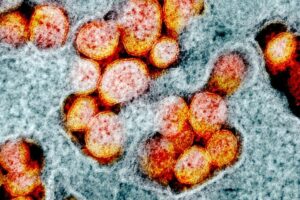According to a new study led by scientists at the University of California, San Francisco’s Quantitative Biosciences Institute (QBI), and the University College London, the Alpha variant of SARS-CoV-2 – the first variant of concern – evolved mutations that allowed it to more efficiently suppress the immune system’s early response to infection.
In their investigation, they noticed that the variation had increased the synthesis of a protein that it utilizes to squelch the immune-stimulating signals produced by infected cells.

Mutations responsible for this transformation most likely aid the Alpha variety in avoiding immune detection and spreading more quickly, and it is crucial to note that comparable mutations exist in the Omicron strain as well.
The findings were published in the December 23 issue of the journal Nature.
The team, led by senior authors Nevan Krogan, Ph.D., of the University of California, San Francisco, and Claire Jolly and Greg Towers, Ph.D., of the University College of London, discovered that Alpha’s enhanced infectivity resulted from mutations outside of “spike,” the proteins that have drawn the majority of scientists’ attention since the outbreak began.
Spike, the mechanism by which the virus enters the cells of its host, is important to infection and is the target of all COVID-19 vaccines now on the market. However, it is only one of a number of methods that the virus uses to control its host.
Krogan stressed that, while scientists have been keenly watching for mutations in the spike region of novel variants – Omicron has over 30 – he believes that changes in other locations may potentially have a significant influence.
Spike has undergone changes that improve the virus’ ability to enter cells. But what happens when the virus has infiltrated the cells? According to Krogan, who also serves as the director of UCSF’s QBI and the Coronavirus Research Group, “there may be other modifications that allow it to proliferate more” (QCRG).
Alpha spread fast all over the world after it was initially discovered in the United Kingdom in late 2020, indicating that it was far more transmissible than the original virus, which was discovered in 1998.
However, studies in Towers’ lab revealed that the new variation did not reproduce any more quickly than its predecessor did.
Looking for an explanation, the QCRG set out to determine whether the new variation had a different interaction with the cells that it infected.
Studying SARS-CoV-2 variations of concern can provide insight into how the virus evolves. We now have a better understanding of the proteins that are most often mutating, as well as the biological repercussions of those mutations.
MEHDI BOUHADDOU is a Ph.D. candidate.
Using data from the Massachusetts Institute of Technology (MIT), the European Molecular Biology Laboratory (EMBL), and the Icahn School of Medicine at Mount Sinai, the team assessed the effect of the variation on host cells in comparison with a virus discovered early in the epidemic.
Postdoctoral scholar Mehdi Bouhaddou, Ph.D., and QBI senior scientist Lorena Zuliani-Alvarez, Ph.D., both of whom were co-lead authors on the paper, assessed the activity of each gene and observed protein levels in laboratory-grown cells infected with the virus.
They also examined the phosphorylation status of the proteins, which is a type of study that reveals chemical alterations that can briefly alter the function of some proteins.
The researchers used this information to compare the response to infection with Alpha and the response to infection with the original virus, and they discovered that many of the significant differences involved the innate immune response, which is the body’s first line of defense against foreign invaders.
In the presence of the SARS-CoV-2 Alpha form, many of the genes involved in mobilizing this response were only weakly active, if at all.
Aside from that, the researchers revealed that the Alpha-infected cells contained high levels of three viral proteins, which are known to aid the virus in evading the body’s immune system reaction.
Further research revealed that one of them, known as Orf9b, is capable of doing this task by latching on to a protein that activates immune-stimulating genes in the body.
The findings show that it may be able to aid the immune system in its fight against SARS-CoV-2 by designing medications that disrupt this connection, and they also provide a potential technique for accomplishing this goal.
Recently, additional varieties have surpassed Alpha in terms of transmission speed, with mutations spurring even more aggressive transmission.
“The virus will continue to evolve and adapt to the host, and with each new adaptation, it will become better and better,” Zuliani-Alvarez explained.
As a result of possessing mutations in two of the three areas analyzed by the team, the Delta and Omicron appear to be cousins of the Alpha, suggesting that they may have similar impacts on the innate immune system.
The findings illustrate the importance of comprehending the whole extent of alterations that influence the behavior of viral variations in order to predict their behavior.
“Understanding the variations of concern provides us with insights into how SARS-CoV-2 evolves,” Bouhaddou explained.
“We now have a better understanding of the proteins that are most commonly mutating, as well as the biological repercussions of those mutations.” “I believe that this will assist us in preparing for what may come next.”

